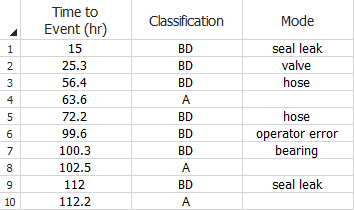Failure Mode Classifications for Crow Extended
For reliability growth data analysis only.
To use the Crow Extended model, you must classify and identify the failure mode responsible for each observed failure. This information is entered in the Classification and Mode columns in the data sheet. These columns are inserted automatically when you choose the Crow Extended model from the Model drop-down list on the growth data folio control panel.
Tip: If the Crow Extended model is not selected but still available for the current data type, you can manually add the Classifications and Mode columns to the data sheet by choosing Growth Data > Format and View > Insert Columns > Projections. This will allow you to record projections data in case you decide to change the model to Crow Extended later. When Crow Extended is not selected, the projections data will not affect the calculations.
The Classification column records the code that describes how the failure mode is treated. The possible codes are described next.
- A indicates that no fix will be applied (i.e., management chooses not to address the failure mode because of technical, financial or other reasons).
- BC indicates that a fix was applied during the observation period. The analysis assumes that the effect of the design improvement was experienced during the observation period and will be reflected in the data.
- BD indicates that the fix will be delayed until after the observation period. You will be required to define the effectiveness factor for each BD mode to estimate the fractional decrease in failure intensity that is expected to occur after the fix has been implemented.
Tip: BC modes are not available for data sheets configured for fielded data or Discrete Mixed data because these data types assume that all design improvements are delayed (i.e., no reliability growth during the observation period). If you are using Discrete Mixed data (i.e., success/failure data from a series of trials on one-shot devices) and you want to account for fixes that were implemented during the test, you can use a data sheet configured for Multi-Phase Mixed data instead. In this sheet, you can enter a BD failure event and its implemented fix event (i.e., "I" event). Such a failure will, in effect, be treated as a BC mode.
The Mode column records the specific failure mode identification, which is optional for A modes but required for all BC and BD modes. This can be entered as either a name or a numerical code (e.g. "seal leak," "1," "BD1," etc.).
The next picture shows the first ten rows of a Failure Times data sheet with failure mode identification and mode classification information.

Tip: If you discover that a certain failure mode was classified incorrectly (e.g., if every "operator error" mode in the above data sheet should have been classified as an A classification instead of BD), or if you want to change a particular mode identifier (e.g., you want to change every instance of a particular number in the Mode column to a name), you can use the Convert Modes window to apply the update automatically.